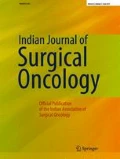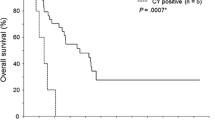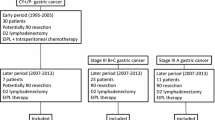Abstract
The survival rates of gastric cancer patients with cytology-positive peritoneal lavage fluid without macroscopic dissemination (CY+/P-) is the same as that of patients with overt peritoneal metastasis.The 5-year survival rate of such patients is only 2%. The current study aims to highlight its significance in the staging of gastrointestinal malignancies and its implications for patient care. Prospective nonrandom analysis of peritoneal wash cytology in patients with gastrointestinal malignancies was conducted in the department of Surgical Gastroenterology, Nizams Institute of Medical Sciences, Hyderabad from January 2012 to June 2013. Descriptive statistics and ANOVA variance analysis was performed to estimate incidence, risk factors and the effect of surgery in causing peritoneal dissemination of malignancy. A total of 60 patients with operable gastric cancer underwent peritoneal lavage for evaluation of malignant cells. The incidence of Positive peritoneal lavage cytology was 8.3% (5/60).Four patients with positive lavage fluid belong to T3 stage (11.7%, p-0.309).Poorly differentiating and mucinous tumors had a higher incidence of positive cytology (18.1% and 25%).None of the patients with positive cytology had positive resection margin. Tumors with advanced T stage, lymph nodal involvement, lympho-vascular and perineural invasion have higher incidence of positive peritoneal cytology. Surgical handling has a negligible effect in peritoneal dissemination of tumor. Large scale studies are warranted to validate the findings and define it’s role in management of gastric cancer.
Similar content being viewed by others
References
Bando E (1999) YonemuraY, Takeshita Y, et al. intraoperative lavagefor cytological examination in 1297 patients with gastric carcinoma. Am J Surg 178:256–262
Lorenzen S, Panzram B, Rosenberg R, et al. (2010) Prognostic significance of free peritoneal tumor cells in the peritoneal cavity before and after neoadjuvant chemotherapy in patients with gastric carcinoma undergoing potentially curative resection. Ann Surg Oncol 17:2733–2739
Vogel P, Ruschoff J, Kummel S, et al. (2000) Prognostic value of microscopic peritoneal dissemination: comparison between colon and gastric cancer. Dis Colon Rectum 43:92–100
Warshaw AL (1991) Implications of peritoneal cytology for staging of early pancreatic cancer. Am J Surg 169:26–34
Nishikawa T, Watanabe T, Sunami E, Tsuno NH, Kitayama J, Nagawa H (2009) Prognostic value of peritoneal cytology and the combination of peritoneal cytology and peritoneal dissemination in colorectal cancer. Dis Col Rectum 52(12):2016–2021
Sue-ing HM, Johnston DIG, Martin MF, Dixon MRJ, Lansdown MJ, McMahon A, Axon TR (1993) Gastric cancer: A curable disease in Britain. BMJ 307(6904):591–596
Allum WH, Powell DJ, McConkey CC (1989) Fielding JWL (1989) gastric cancer: a 25-year review. Br J Surg 76:535–540
Gunderson LL (1982) Sosin H et al adenocarcinoma of the stomach: areas of failure in a re-operation series (second or symptomatic look) clinic-pathologic correlation and implications for adjuvant therapy. Int J Radiat Oncol Biol Phys 8(1):1–11
Nakajima T, Harashima S, Hirata M, Kajitani T (1978) Prognostic and therapeutic value of peritoneal cytology in gastric cancer. Acta Cytol 22:225–229
Bonenkamp JJ, Songun I, Hermans J, van de Velde CJH (1996) Prognostic value of positive cytology findings from abdominal washings in patients with gastric cancer. Br J Surg 1996(83):672–674
Boku T, Nakane Y, Minoura T, Takada H, Yamamura M, Hioki K, Yamamoto M (1990) Prognostic significance of serosal invasion and free intraperitoneal cancer cells in gastric cancer. Br J Surg 77:436–439
Kimura Y, Hayashi K, Sasagawa T, et al. (2003) Pilot study of S-1 in patients withdisseminated gastric cancer. Drugs Exp Clin Res 29:125–130
Kunisaki C, Shimada H, Akiyama H, et al. (2006) Therapeutic outcomes of continuous hyperthermic peritoneal perfusion against advanced gastric cancer with peritoneal carcinomatosis. Hepatogastroenterology 53:473–478
Kuroda Y, Horikawa N, Takada O, Hasebe K, Kawamura T, Tsugawa K, Maeda K, Yabushita K, Konishi K, Tsuji (1995) Factors influencing t1 cancer of the stomach on recurrence following analysis of the clinic-pathological reference and clinical course (in Japanese with English abstract). Jpn J Gastroenterol Surg 28:1653–1659
Mochizuki F, Fujii M, Kasakura Y, Suzuki T, Kanamori N, Kochi M, Yamagata M, Iwai S (2000) Analysis of recurrence in earlygastric cancer: multivariate analysis of risk factors using logistic regression (in Japanese with English abstract). Jpn J Gastroenterol Surg 33:440–447
Shimada S, Yagi Y, Shiomori K, Honmyo U, Hayashi N, Matsuo A, Marutsuka T, Ogawa M (2001) Characterization of earlygastric cancer and proposal of optimal therapeutic strategy. Surgery 129:714–719
Fink AS, Longmire WP (1991) Carcinoma of stomach. In: Subiston DC (ed) Textbook of surgery, 14th edn. WB Saunders, Philadelphia, pp. 814–827
Kodera Y, Yamamura Y, Shimizu Y, Torii A, Hirai T, Yasui K, Morimoto T, Kato T (1999) Peritoneal washing cytolog: prognostic value of positive findings in patients with gastric carcinoma undergoing a potentially curative resection. J Surg Oncol 72:60–65
Han TS, Kong SH, Lee HJ, Ahn HS, Hur K, Yu J, Kim WH, Yang HK (2011) Dissemination of free cancer cells from the gastric lumen and from perigastric lymphovascular pedicles during radical gastric cancer surgery. Ann Surg Oncol 18(10):2818–2825
Marutsuka T, Shimada S, Shiomori K, Hayashi N, Yagi Y, Yamane T, Ogawa M (2003) Mechanisms of peritoneal metastasis after operation for non-serosa-invasive gastric carcinoma: an ultrarapid detection system for intraperitoneal free cancer cells and a prophylactic strategy for peritoneal metastasis. Clin Cancer Res 9(2):678–685
Yu XF, Ren ZG, Xue YW, Song HT, Wei YZ, Li CM (2013) D2 lymphadenectomy can disseminate tumor cells into peritoneal cavity in patients with advanced gastric cancer. Neoplasma. 60(2):174–181
Ajani A, Bentrem D, Besh S, et al. (2013) NCCN Clinical Practice Guidelines in Oncology: Gastric Cancer. Version 2.2013:www.nccn.org
Power DG, Schattner MA, Gerdes H, et al. (2009) Endoscopic ultrasoundcan improve the selection for laparoscopy in patients with localizedgastric cancer. J Am Coll Surg 208:173–178.14
Yang XJ, Huang CQ, Suo T, et al. (2011) Cytoreductive surgery and hyperthermic intraperitoneal chemotherapy improves survival of patients with peritoneal carcinomatosis from gastric cancer: final results of a phase III randomized clinical trial. Ann Surg Oncol 18:1575–1158
Leather AJ, Kocjan G, Savage F, et al. (1994) Detection of free malignant cells in the peritoneal cavity before and after resection of colorectal cancer. Dis Colon Rectum 37:814–819
Hase K, Ueno H, Kuranaga N, Utsunomija K, Kanabe S, Mochizuki H (1998) Intraperitoneal exfoliated cancer cells in patients with colorectal cancer. Dis Colon Rectum 41:1134–1140
Author information
Authors and Affiliations
Corresponding author
Ethics declarations
Ethics Approval
Informed consent was obtained from all patients and the study was approved by Institutional ethics committee and the protocol approved by IRB.
Rights and permissions
About this article
Cite this article
Koganti, S.B., Boddepalli, S., Nambada, M. et al. Positive Peritoneal Lavage Cytology –Implications for Staging and Management of Gastric Cancer. Indian J Surg Oncol 7, 430–435 (2016). https://doi.org/10.1007/s13193-016-0527-z
Received:
Accepted:
Published:
Issue Date:
DOI: https://doi.org/10.1007/s13193-016-0527-z




